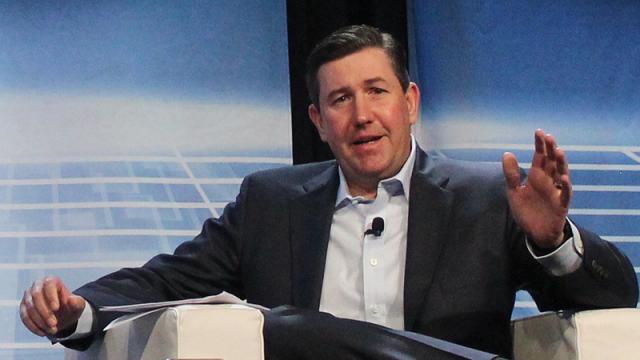
Jay Salitza, managing director for oil and gas at KeyBanc Capital Markets Inc., explains why he is optimistic about natural gas at DUG Haynesville on May 26. (Source: Joseph Markman/Hart Energy)
SHREVEPORT, La.—Capital discipline is the secret sauce that has vaulted the oil and gas sector ahead of all others in the stock market this year, but from a relative value perspective, energy companies are still trading fairly modestly, a markets expert said May 26.
Energy companies as a whole are trading at 8x EBITDA and account for about 5% of the S&P 500 index, said Jay Salitza, managing director for oil and gas at KeyBanc Capital Markets Inc., at Hart Energy’s DUG Haynesville conference and exhibition. By contrast, the technology sector trades at 17x EBITDA and constitutes about 25% of the index.
“So, you’re either going to see a lot more running room for gas stocks, or further compression from the tech space over time,” Salitza said. “Oil and gas, in our opinion, continues to show the ability to return capital to shareholders.”
There are challenges, though. Companies in the sector, like every entity in this economy, are struggling in an environment of high inflation, he said. Interest rates are also rising.
“For the near term, it seems to be modest to flat growth and preservation of capital, as opposed to more significant growth aspects,” Salitza said.
He also noted how private equity firms have been forced to pivot their strategies significantly in the last two years.
“Historically, they’ve always been very IRR (internal rate of return)-based in their approach,” Salitza said. Now, investments are made with an eye toward the longer term and free cash flow.
The $9 misnomer
The lofty price of natural gas, which lingered above $9/MMBtu for most of the day on May 26, pervaded the atmosphere at DUG Haynesville. Gas actually closed down more than 12 cents to $8.785/MMBtu at the close of trading, but rose as high as $9.38 at mid-morning.
But Salitza cautioned against irrational exuberance.
“It’s hard to not be optimistic when you see a $9 price tag on the strip, but you have to think about the fundamentals of the natural gas space,” he said.
Part of the issue is that, in the day-to-day energy business, $9 isn’t always $9.
“Most companies have production fairly well hedged for 2022,” Salitza said. “In most cases, 60%-70% of production is hedged. In some cases, there is expected production beyond that. So, although you see $9 on the screen, a lot of companies are not enjoying the benefit of $9 to their cash flow.”
They’re certainly seeing a premium cash flow, he added, but not always $9, or what the high price of the day happens to be.
Another aspect of fundamentals, however, is storage. Natural gas inventories have been trending 15%-20% below the five-year average for storage, which is a key metric for traders. Tight storage combined with a spike of consumption caused by a cold winter could send prices soaring. To Salitza, it’s an indicator that natural gas prices will show relative strength for quite some time.
Exports are another cause for optimism. Shipments of pipelined gas and LNG rose 30% in 2019 from 2018. Despite the pandemic, 2020 still experienced a 15% increase in exports, and 2021 registered a 25% increase over 2020.
“That market doesn’t seem to be slowing any time soon,” he said. “It’s going to be continuing to grow for many, many more years to come.”
Recommended Reading
Defeating the ‘Four Horsemen’ of Flow Assurance
2024-04-18 - Service companies combine processes and techniques to mitigate the impact of paraffin, asphaltenes, hydrates and scale on production—and keep the cash flowing.
Tech Trends: AI Increasing Data Center Demand for Energy
2024-04-16 - In this month’s Tech Trends, new technologies equipped with artificial intelligence take the forefront, as they assist with safety and seismic fault detection. Also, independent contractor Stena Drilling begins upgrades for their Evolution drillship.
AVEVA: Immersive Tech, Augmented Reality and What’s New in the Cloud
2024-04-15 - Rob McGreevy, AVEVA’s chief product officer, talks about technology advancements that give employees on the job training without any of the risks.
Lift-off: How AI is Boosting Field and Employee Productivity
2024-04-12 - From data extraction to well optimization, the oil and gas industry embraces AI.
AI Poised to Break Out of its Oilfield Niche
2024-04-11 - At the AI in Oil & Gas Conference in Houston, experts talked up the benefits artificial intelligence can provide to the downstream, midstream and upstream sectors, while assuring the audience humans will still run the show.






